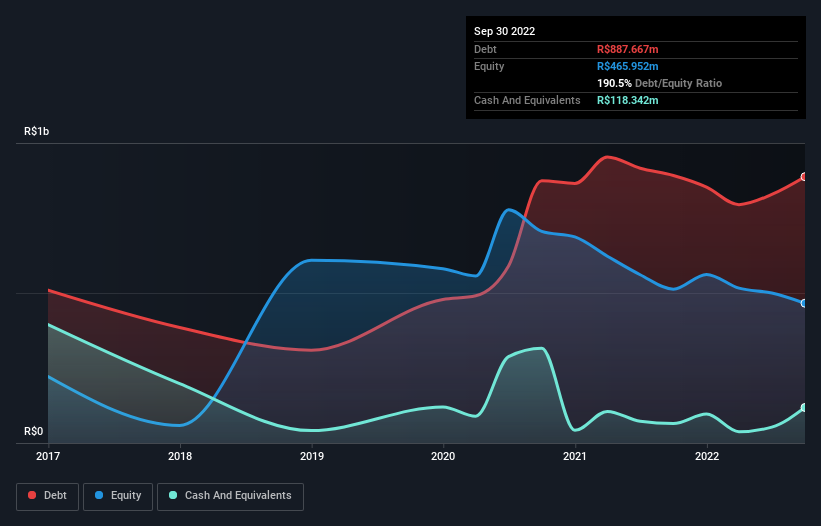- Brazil
- /
- Commercial Services
- /
- BOVESPA:ALPK3
These 4 Measures Indicate That Allpark Empreendimentos Participações e Serviços (BVMF:ALPK3) Is Using Debt Extensively

Legendary fund manager Li Lu (who Charlie Munger backed) once said, 'The biggest investment risk is not the volatility of prices, but whether you will suffer a permanent loss of capital.' It's only natural to consider a company's balance sheet when you examine how risky it is, since debt is often involved when a business collapses. As with many other companies Allpark Empreendimentos, Participações e Serviços S.A. (BVMF:ALPK3) makes use of debt. But should shareholders be worried about its use of debt?
When Is Debt Dangerous?
Debt assists a business until the business has trouble paying it off, either with new capital or with free cash flow. Part and parcel of capitalism is the process of 'creative destruction' where failed businesses are mercilessly liquidated by their bankers. However, a more frequent (but still costly) occurrence is where a company must issue shares at bargain-basement prices, permanently diluting shareholders, just to shore up its balance sheet. Of course, plenty of companies use debt to fund growth, without any negative consequences. The first step when considering a company's debt levels is to consider its cash and debt together.
See our latest analysis for Allpark Empreendimentos Participações e Serviços
What Is Allpark Empreendimentos Participações e Serviços's Net Debt?
As you can see below, Allpark Empreendimentos Participações e Serviços had R$887.7m of debt, at September 2022, which is about the same as the year before. You can click the chart for greater detail. However, it does have R$118.3m in cash offsetting this, leading to net debt of about R$769.3m.

How Strong Is Allpark Empreendimentos Participações e Serviços' Balance Sheet?
The latest balance sheet data shows that Allpark Empreendimentos Participações e Serviços had liabilities of R$671.5m due within a year, and liabilities of R$1.47b falling due after that. Offsetting this, it had R$118.3m in cash and R$164.2m in receivables that were due within 12 months. So its liabilities outweigh the sum of its cash and (near-term) receivables by R$1.86b.
The deficiency here weighs heavily on the R$321.4m company itself, as if a child were struggling under the weight of an enormous back-pack full of books, his sports gear, and a trumpet. So we definitely think shareholders need to watch this one closely. After all, Allpark Empreendimentos Participações e Serviços would likely require a major re-capitalisation if it had to pay its creditors today.
We measure a company's debt load relative to its earnings power by looking at its net debt divided by its earnings before interest, tax, depreciation, and amortization (EBITDA) and by calculating how easily its earnings before interest and tax (EBIT) cover its interest expense (interest cover). Thus we consider debt relative to earnings both with and without depreciation and amortization expenses.
While Allpark Empreendimentos Participações e Serviços's debt to EBITDA ratio (3.1) suggests that it uses some debt, its interest cover is very weak, at 0.62, suggesting high leverage. It seems clear that the cost of borrowing money is negatively impacting returns for shareholders, of late. The good news is that Allpark Empreendimentos Participações e Serviços grew its EBIT a smooth 37% over the last twelve months. Like a mother's loving embrace of a newborn that sort of growth builds resilience, putting the company in a stronger position to manage its debt. When analysing debt levels, the balance sheet is the obvious place to start. But ultimately the future profitability of the business will decide if Allpark Empreendimentos Participações e Serviços can strengthen its balance sheet over time. So if you're focused on the future you can check out this free report showing analyst profit forecasts.
Finally, a company can only pay off debt with cold hard cash, not accounting profits. So we always check how much of that EBIT is translated into free cash flow. During the last three years, Allpark Empreendimentos Participações e Serviços burned a lot of cash. While investors are no doubt expecting a reversal of that situation in due course, it clearly does mean its use of debt is more risky.
Our View
To be frank both Allpark Empreendimentos Participações e Serviços's conversion of EBIT to free cash flow and its track record of staying on top of its total liabilities make us rather uncomfortable with its debt levels. But at least it's pretty decent at growing its EBIT; that's encouraging. We're quite clear that we consider Allpark Empreendimentos Participações e Serviços to be really rather risky, as a result of its balance sheet health. So we're almost as wary of this stock as a hungry kitten is about falling into its owner's fish pond: once bitten, twice shy, as they say. When analysing debt levels, the balance sheet is the obvious place to start. But ultimately, every company can contain risks that exist outside of the balance sheet. For example Allpark Empreendimentos Participações e Serviços has 4 warning signs (and 2 which make us uncomfortable) we think you should know about.
At the end of the day, it's often better to focus on companies that are free from net debt. You can access our special list of such companies (all with a track record of profit growth). It's free.
New: Manage All Your Stock Portfolios in One Place
We've created the ultimate portfolio companion for stock investors, and it's free.
• Connect an unlimited number of Portfolios and see your total in one currency
• Be alerted to new Warning Signs or Risks via email or mobile
• Track the Fair Value of your stocks
Have feedback on this article? Concerned about the content? Get in touch with us directly. Alternatively, email editorial-team (at) simplywallst.com.
This article by Simply Wall St is general in nature. We provide commentary based on historical data and analyst forecasts only using an unbiased methodology and our articles are not intended to be financial advice. It does not constitute a recommendation to buy or sell any stock, and does not take account of your objectives, or your financial situation. We aim to bring you long-term focused analysis driven by fundamental data. Note that our analysis may not factor in the latest price-sensitive company announcements or qualitative material. Simply Wall St has no position in any stocks mentioned.
About BOVESPA:ALPK3
Allpark Empreendimentos Participações e Serviços
Allpark Empreendimentos, Participações e Serviços S.A.
Undervalued with limited growth.
Market Insights
Community Narratives



